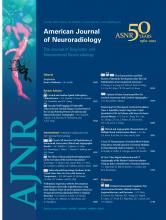Research ArticlePediatrics
Toward a Better Understanding of Brain Lesions during Metachromatic Leukodystrophy Evolution
A. Martin, C. Sevin, C. Lazarus, C. Bellesme, P. Aubourg and C. Adamsbaum
American Journal of Neuroradiology October 2012, 33 (9) 1731-1739; DOI: https://doi.org/10.3174/ajnr.A3038
A. Martin
aFrom AP-HP, Bicêtre Hospital, Pediatric Radiology Department (A.M., C.A.)
C. Sevin
bNeuropediatrics Department (C.S., C.B., P.A.)
C. Lazarus
cLe Kremlin Bicêtre, France; AP-HP, Cochin-Broca-Hôtel Dieu Hospital, Unit of Epidemiology and Biostatistics (C.L.), Paris, France
dParis Descartes University, Faculty of Medecine (C.A., C.L., P.A.), Paris, France.
C. Bellesme
bNeuropediatrics Department (C.S., C.B., P.A.)
P. Aubourg
bNeuropediatrics Department (C.S., C.B., P.A.)
dParis Descartes University, Faculty of Medecine (C.A., C.L., P.A.), Paris, France.
C. Adamsbaum
aFrom AP-HP, Bicêtre Hospital, Pediatric Radiology Department (A.M., C.A.)
dParis Descartes University, Faculty of Medecine (C.A., C.L., P.A.), Paris, France.

References
- 1.↵
- Cheon JE,
- Kim IO,
- Hwang YS,
- et al
- 2.↵
- Fluharty AL
- 3.↵
- Demaerel P,
- Faubert C,
- Wilms G,
- et al
- 4.↵
- Cartier N,
- Aubourg P.
- 5.↵
- Eichler F,
- Grodd W,
- Grant E,
- et al
- 6.↵
- Friede RL
- 7.↵
- Molander-Melin M,
- Pernber Z,
- Franken S,
- et al
- 8.↵
- 9.↵
- Barkovich AJ,
- Kjos BO.
- 10.↵
- Rakic P,
- Yakovlev PI.
- 11.↵
- Engelbrecht V,
- Scherer A,
- Rassek M,
- et al
- 12.↵
- Sener RN.
- 13.↵
- Kim TS,
- Kim IO,
- Kim WS,
- et al
- 14.↵
- Loes DJ,
- Hite S,
- Moser H,
- et al
- 15.↵
- Sener RN.
- 16.↵
- Patay Z.
- 17.↵
- Galanaud D,
- Aubourg P,
- Kalifa G,
- et al
- 18.↵
- Dali C,
- Hanson LG,
- Barton NW,
- et al
- 19.↵
- Kruse B,
- Hanefeld F,
- Christen HJ,
- et al
- 20.↵
- Hayakawa K,
- Kanda T,
- Hashimoto K,
- et al
- 21.↵
- Iai M,
- Tanabe Y,
- Goto M,
- et al
- 22.↵
- Panigrahy A,
- Barnes PD,
- Robertson RL,
- et al
- 23.↵
- Autti T,
- Joensuu R,
- Aberg L.
- 24.↵
- Bloembergen N,
- Purcell EM,
- Pound RV.
- 25.↵
- Ge Y,
- Jensen JH,
- Lu H,
- et al
- 26.↵
- Neema M,
- Stankiewicz J,
- Arora A,
- et al
- 27.↵
- Bakshi R,
- Dmochowski J,
- Shaikh ZA,
- et al
- 28.↵
- Bakshi R,
- Benedict RH,
- Bermel RA,
- et al
- 29.↵
- Bermel RA,
- Puli SR,
- Rudick RA,
- et al
- 30.↵
- Houtchens MK,
- Benedict RH,
- Killiany R,
- et al
- 31.↵
- Mesaros S,
- Rocca MA,
- Absinta M,
- et al
- 32.↵
- Goodman A
- 33.↵
- Smith EE,
- Salat DH,
- Jeng J,
- et al
In this issue
Advertisement
A. Martin, C. Sevin, C. Lazarus, C. Bellesme, P. Aubourg, C. Adamsbaum
Toward a Better Understanding of Brain Lesions during Metachromatic Leukodystrophy Evolution
American Journal of Neuroradiology Oct 2012, 33 (9) 1731-1739; DOI: 10.3174/ajnr.A3038
0 Responses
Jump to section
Related Articles
Cited By...
- No citing articles found.
This article has not yet been cited by articles in journals that are participating in Crossref Cited-by Linking.
More in this TOC Section
Similar Articles
Advertisement











